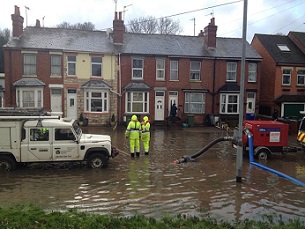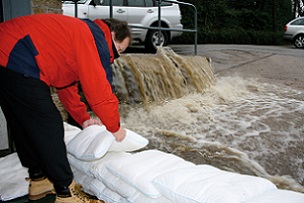 Flooding can have devastating consequences on people's mental health
Flooding can have devastating consequences on people's mental health
 A flooded home can take many months to repair
A flooded home can take many months to repair
 FloodSax alternative sandbags can hold back a torrent of floodwater
FloodSax alternative sandbags can hold back a torrent of floodwater
 They are space-saving to store so are always available for peace of mind
They are space-saving to store so are always available for peace of mind
 Multifunctional FloodSax can be used indoors too to soak up leaks and spills, often in hard-to-reach places
Multifunctional FloodSax can be used indoors too to soak up leaks and spills, often in hard-to-reach places
The many reasons why flooding has a severe impact on mental health
Flooding now causes far more problems to people’s mental health than physical injuries and the best way to prevent this is to stop the floodwater getting into homes and businesses in the first place.
The link between flooding and mental health is so bad that the Government has issued new guidelines in July 2022 called Flooding and Health: Assessment and Management of Public Mental Health.
The guide is for public health and local authorities, emergency services, frontline health professionals and other public organisations who deal with people at most risk from the psychosocial impacts of flooding and suggests a series of steps to be taken to reduce the health risk.
But the report stresses: “Prevention of floodwater entering a property and minimising the damage to homes is the primary method of prevention of much of the burden of mental ill health.”
It also reveals that mental health problems caused by flooding can surface months or even years later so the care needed may have to continue for a long time.
The Government study discovered that people who had suffered flooding are more likely to have symptoms of post-traumatic stress disorder (PTSD), depression and anxiety between 6 months to 3 years after their flooding trauma.
People whose homes had been flooded were up to 6 times more likely to have probable PTSD, depression and/or anxiety than people who had not been flooded.
The report states: “Significant mental health impacts were experienced by those with floodwater in the home. The extent of these impacts was affected by the amount of time the floodwater stayed in the home and the levels of the floodwater present.”
It’s staggering just how many ways flooding can trigger mental health problems. Even people whose properties have not been flooded but live nearby can have symptoms of mental health disorders caused by loss of gas, water and electricity, loss of access to health and social care services and increased health concerns.
So what are the reasons why flooding triggers problems with mental health?
While not an exhaustive list, here are some of the main ones.
- Destruction of homes or businesses.
- People forced to leave their properties, sometimes for months or even years.
- Loss of electricity, gas and water.
- Money worries including concerns about the cost of house repairs, how long they will take and the property’s value falling.
- Problems dealing with insurance claims and compensation.
- Loss of employment and/or income.
- Feelings of loss of control and fear of recurrence of another extreme event and heightened anxiety, especially for those with existing anxiety or past trauma.
- Family-related stress with normal routines turned upside down, separated from friends and family.
- Disruption of access to health services.
- Loss of sentimental items.
- Concerns about health of family and friends.
- Lack of access to healthcare, new or continuing health concerns or conditions and lack of access to prescription medications can put people at greater risk of psychological effects of flooding. This may be worse for those with learning disabilities, autism or dementia due to a change in routine and surroundings.
- Stress relating to education and schooling if there is a need to move area or the school is flooded and damaged. There is also the loss of socialisation associated with attending school.
The Government report warns that a lot of mental health issues are left untreated after floods and this needs to change.
It states: “Often people with symptoms of mental ill health do not seek help from formal sources. It is likely there is a significant unrecognised burden of mental ill health after flooding within communities.
“With improved identification, those individuals who would benefit from access to specialist psychological healthcare can be supported to access the right support to meet their personal needs and circumstances.”
Many people don’t realise that local councils have absolutely no responsibility to provide sandbags and it’s down to people to protect their own properties from any kind of flooding including flash flooding, river flooding (known as fluvial flooding), groundwater flooding, sewer flooding and coastal flooding.
The Environment Agency states: “Don’t assume the authorities will provide you with sand bags in a flood emergency. It’s the responsibility of property owners to take appropriate action to protect their property from flooding. Sandbags are relatively ineffective when compared to purpose-built flood protection products. We strongly encourage people to use these products.”
One that is widely used by local councils, flood action groups, businesses and the general public are FloodSax alternative sandbags.
FloodSax (http://www.floodsax.co.uk/) are multi-purpose so can be used to prevent flooding both inside and outside properties. Outside, simply immerse them in water and the gelling polymer inside absorbs the water so they expand to become sandless sandbags which can be made into temporary flood barriers or flood walls.
In their dry state they are flat with a large absorbent surface area so they can be popped beneath pipes, under floorboards and in other hard-to-reach places to soak up leaks, drips, spills and internal floods from leaking pipes, radiators, boilers and kitchen sinks.
The Government guidelines says more needs to be done in areas vulnerable to flooding such as formal community engagement regarding flood awareness and resilience and institutional support for community flood action groups.